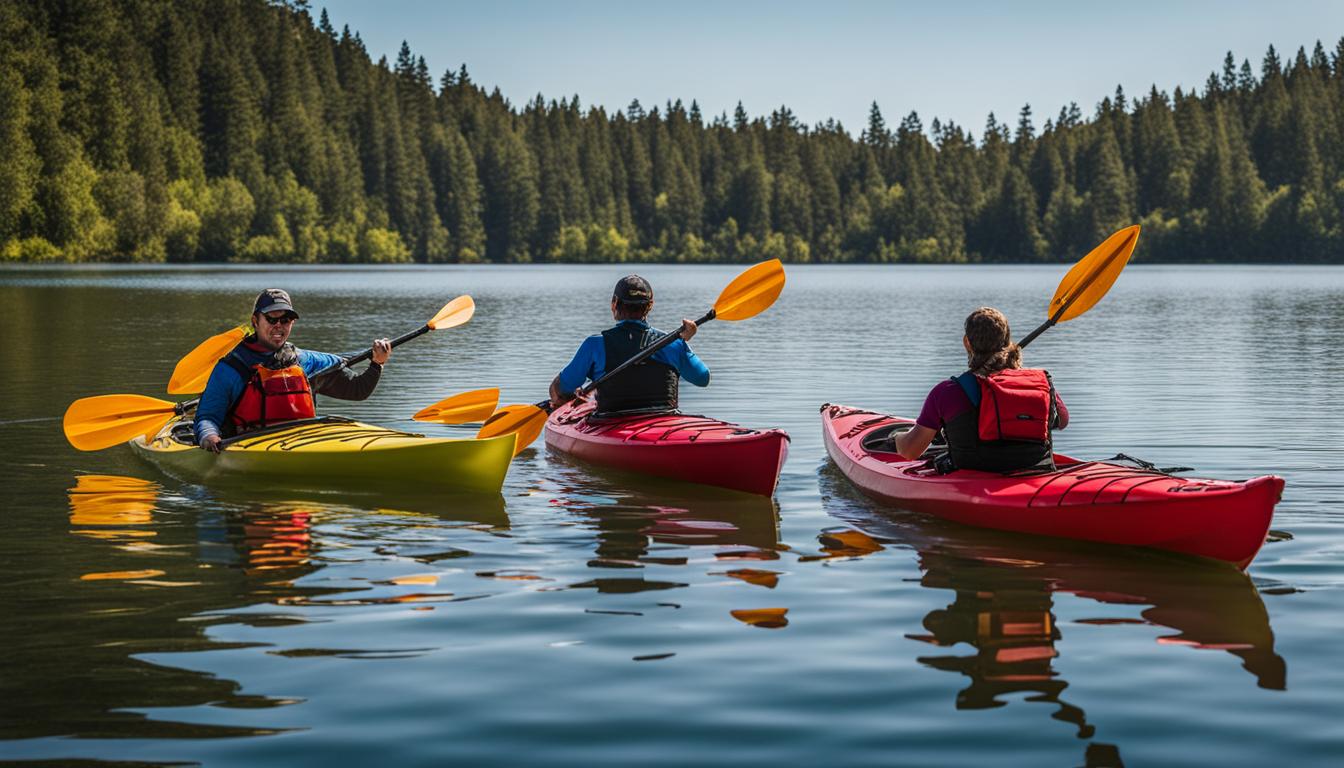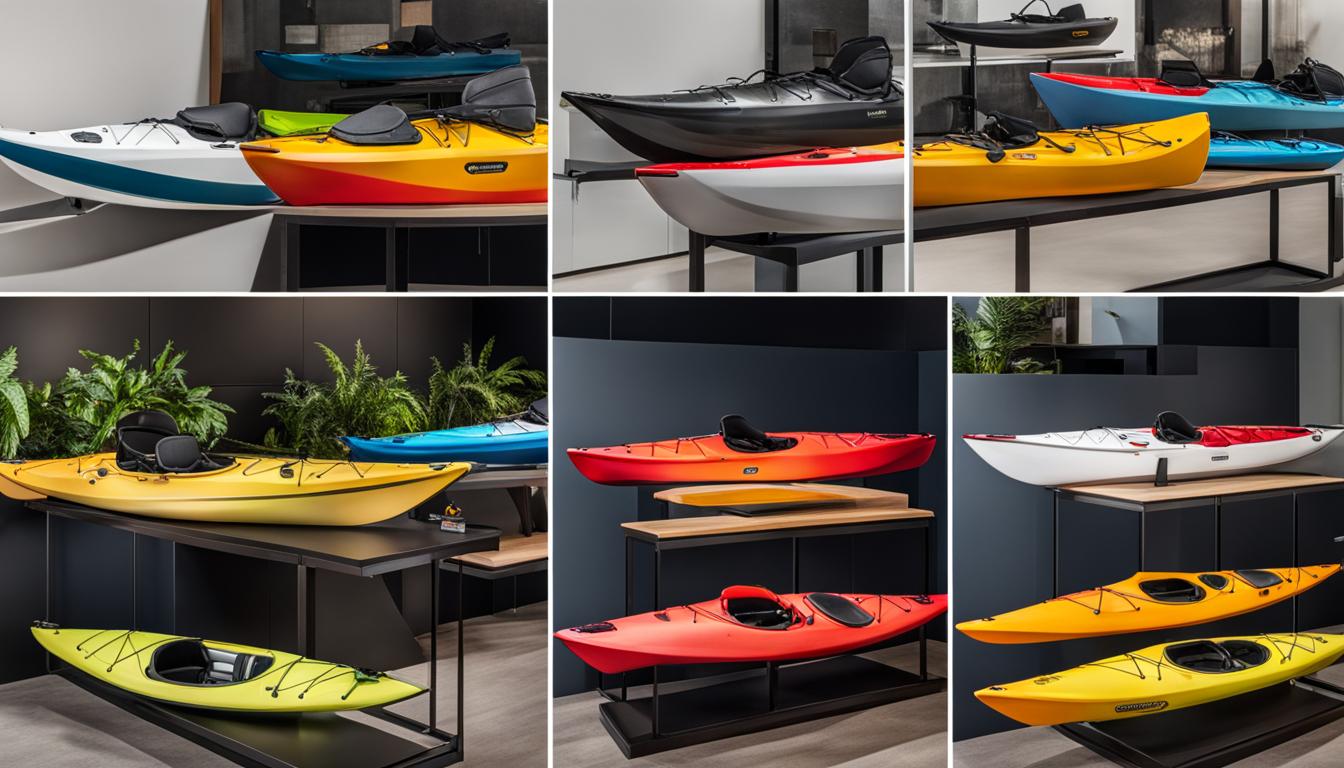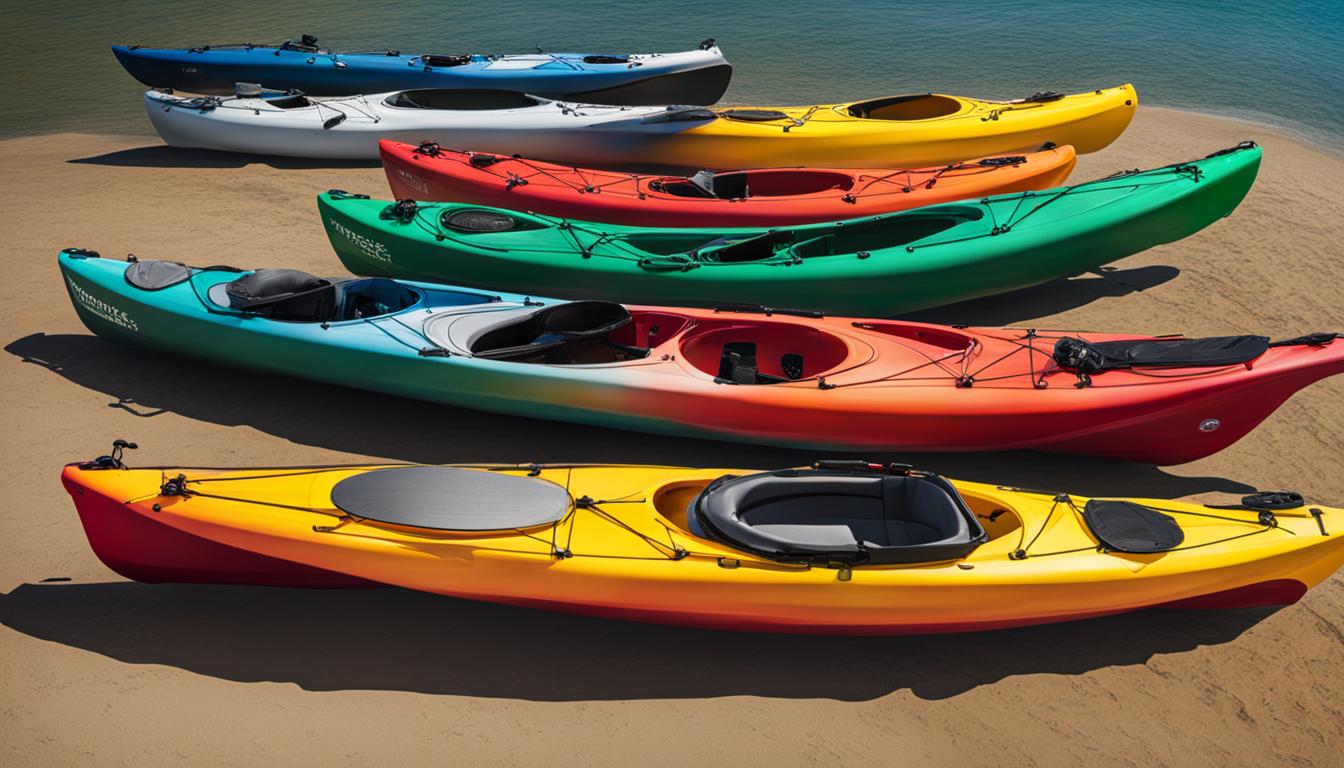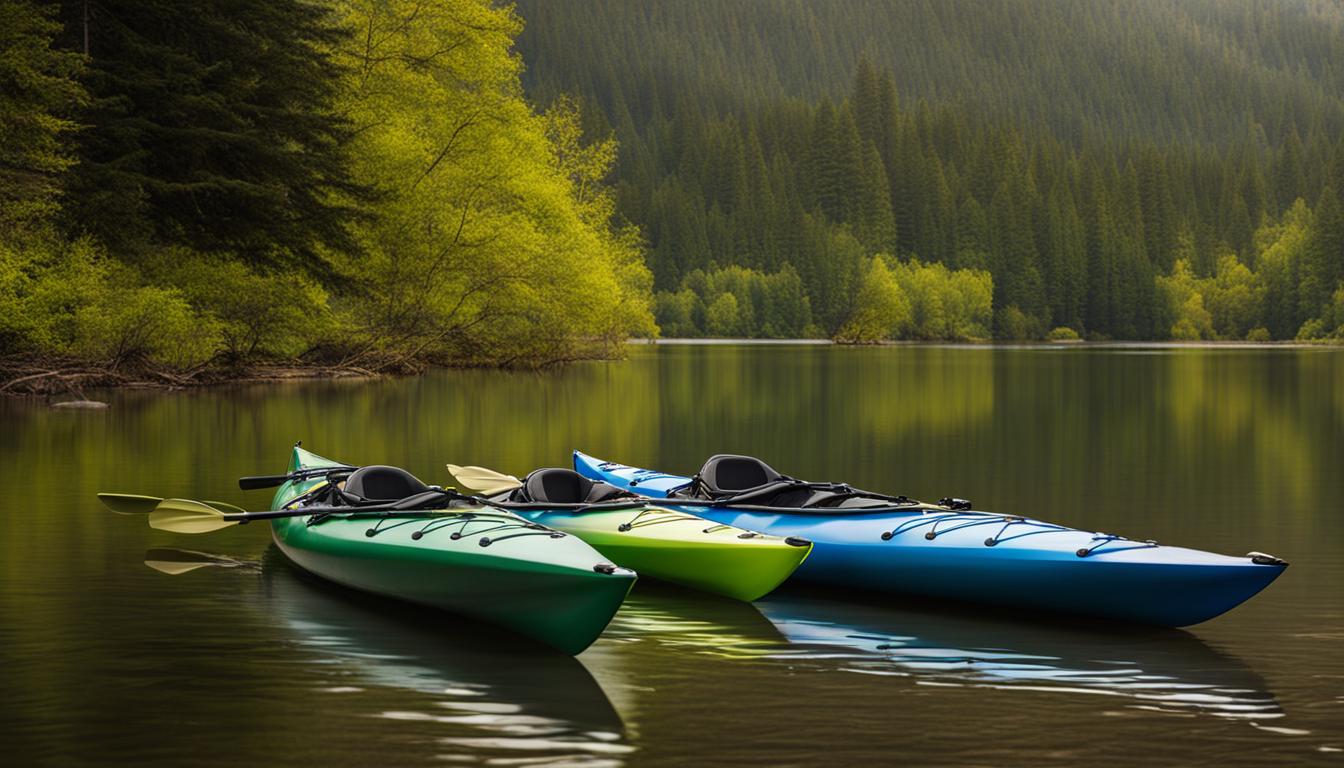Kayaking is a popular hobby that offers various activities like leisure, fishing, touring, and whitewater rapids. When choosing a kayak, the size, particularly the length, is crucial. Factors to consider include the purpose of kayaking, the length to width ratio, and the legroom needed for comfort and control. Different types of kayaks, such as recreational, fishing, and sea/touring kayaks, have varying dimensions that cater to specific needs. It’s important to note that a kayak’s length doesn’t significantly impact its performance, but the cockpit dimensions play a crucial role in providing a comfortable fit for different body types. Referencing a kayak length for height chart can also help determine the appropriate kayak size.
Key Takeaways:
- Choosing the right size kayak is essential for a comfortable and enjoyable paddling experience.
- Factors to consider include the purpose of kayaking, the length to width ratio, and the legroom needed for comfort and control.
- Different types of kayaks have varying dimensions that cater to specific needs.
- A kayak’s length doesn’t significantly impact its performance, but the cockpit dimensions play a crucial role in providing a comfortable fit.
- Referencing a kayak length for height chart can help determine the appropriate size.
Factors to Consider When Choosing the Optimal Kayak Size
When it comes to choosing the right kayak size, there are several factors that you need to take into consideration. First and foremost, the purpose of your kayaking adventures will play a significant role in determining the optimal size. Whether you plan on tackling calm waters, navigating whitewater rapids, or exploring sea environments, each activity requires a different kayak size for optimal performance and safety.
The length to width ratio of the kayak is another important factor to consider. A longer kayak will offer better speed and tracking, making it ideal for covering long distances. On the other hand, a wider kayak will provide more stability, which is crucial for beginners or those who prefer a leisurely pace. Striking a balance between length and width will ensure that you have a kayak that offers both speed and stability.
Comfort is key when it comes to kayaking, so you’ll want to choose a kayak size that provides ample legroom. Having enough space to comfortably sit and maneuver the kayak is essential for an enjoyable experience on the water. It’s important to find the right balance between a snug fit for control and enough room to move your legs without feeling cramped.
“The size of the kayak directly impacts your comfort and overall experience on the water. Choosing the right size is crucial for ensuring that you have a kayak that meets your specific needs and provides optimal comfort and performance.”
Ultimately, determining the optimal kayak size requires careful consideration of your needs, the type of kayaking you’ll be doing, and your comfort level. Taking these factors into account will help you select a kayak that is the perfect fit for your adventures on the water.
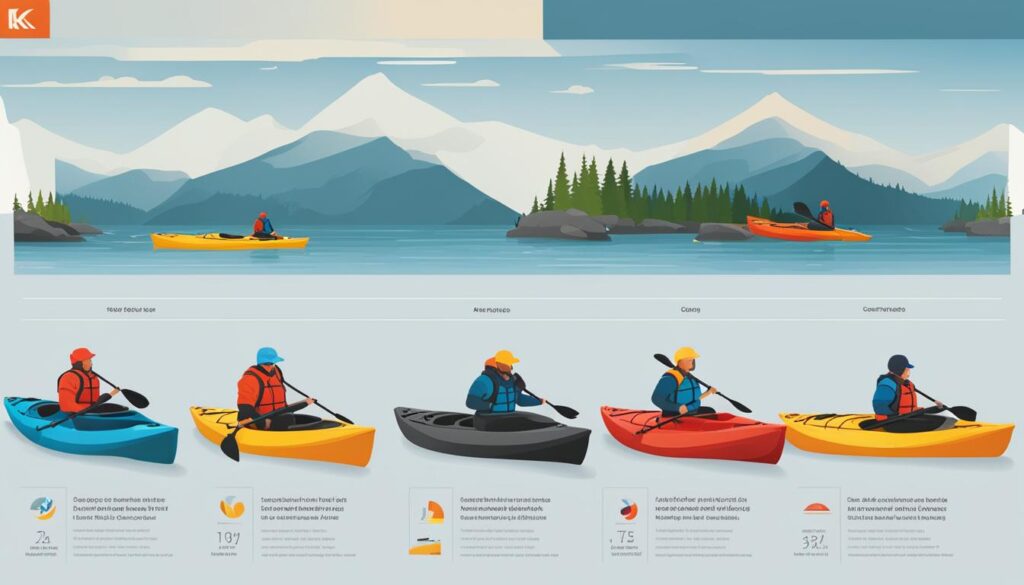
Different Types of Kayaks and Their Dimensions
When it comes to choosing the right kayak size, understanding the different types of kayaks and their dimensions is essential. Each type of kayak is designed for specific purposes and comes with varying dimensions that cater to different needs. By matching the kayak size to your paddling style and body type, you can ensure a comfortable and enjoyable kayaking experience.
Recreational Kayaks
Recreational kayaks are popular among beginners and casual paddlers. They are shorter and wider, offering stability and ease of maneuverability. The wider width provides excellent stability, making it ideal for calm waters and leisure activities. Recreational kayaks typically have a spacious cockpit, allowing for easier entry and exit.
Fishing Kayaks
If you’re an avid angler, a fishing kayak is the perfect choice. Fishing kayaks have a specific design to accommodate the needs of anglers, with features like rod holders and storage compartments for gear. They offer lateral stability for casting and reeling in fish, and some models even have standing platforms for better visibility and casting control.
Sea/Touring Kayaks
For those who love long-distance trips and exploring the sea, sea/touring kayaks are the way to go. These kayaks are longer and narrower, allowing for efficient paddling and increased speed. The sleek design helps them glide through the water effortlessly. Sea/touring kayaks also have ample storage space for gear, making them suitable for multi-day expeditions.
| Kayak Type | Length (feet) | Width (inches) | Weight Capacity (pounds) |
|---|---|---|---|
| Recreational | 8-12 | 28-32 | 250-350 |
| Fishing | 10-14 | 30-40 | 300-500 |
| Sea/Touring | 12-18 | 20-24 | 350-600 |
These dimensions serve as a general guide, but it’s important to note that individual comfort and preferences should also be considered when choosing the ideal kayak size. Trying out different kayaks and sitting in them to assess the fit is the best way to ensure a proper match for your build.
Does The Length of a Kayak Matter
When choosing a kayak, many people place a lot of emphasis on the length of the kayak. However, contrary to popular belief, the length of a kayak doesn’t significantly impact its performance. Instead, it’s the dimensions of the cockpit that play a crucial role in providing a comfortable fit for different body types, especially for taller individuals.
If you’re a taller paddler with a higher center of gravity, longer legs, or larger feet, it’s important to consider the cockpit opening length and width when selecting a kayak. This will ensure that you have enough legroom and space to comfortably maneuver the kayak while maintaining control.
One helpful tool to guide you in finding the right kayak length for your height is a kayak length for height chart. This chart provides recommendations based on height, but it’s important to keep in mind that these are just guidelines and individual comfort should always take precedence over weight capacity.
| Height | Kayak Length |
|---|---|
| Under 5’6″ | 9-12 feet (recreational kayak) |
| 5’6″ – 6’0″ | 12-14 feet (touring kayak) |
| Above 6’0″ | 14-16 feet (touring kayak) |
Remember, finding the right kayak length is just one piece of the puzzle. It’s also important to consider other factors like kayak volume, legroom, and overall comfort to ensure that you pick the best kayak for your height and body type.
Kayak Volume – What Does It Mean
When choosing a kayak, understanding the concept of kayak volume is crucial. Kayak volume refers to the amount of space inside the kayak, and it plays a significant role in determining the suitability of a kayak for different paddlers. Manufacturers often describe kayak volume using terms such as low volume, medium volume, or high volume. Low volume kayaks are designed for shorter and lighter paddlers, providing a snug fit that enhances control and maneuverability.
Medium volume kayaks cater to average-sized individuals and offer a balanced combination of stability and performance. These kayaks provide enough space for comfort without sacrificing maneuverability. On the other hand, high volume kayaks are specifically designed for taller and heavier paddlers or those embarking on longer trips with essential gear. The additional volume in these kayaks enhances buoyancy and stability, ensuring a safe and enjoyable paddling experience.
Remember, finding the right kayak volume is crucial to ensure a comfortable and efficient paddling experience. Sitting in the kayak and evaluating the fit is the best way to determine if the volume is suitable for your height and body type.
Table: Comparison of Kayak Volumes
| Kayak Volume | Target Paddler | Suitable Activities |
|---|---|---|
| Low Volume | Shorter and lighter paddlers | Controlled maneuverability, playboating, surfing |
| Medium Volume | Average-sized paddlers | Recreational paddling, day trips, light touring |
| High Volume | Taller and heavier paddlers | Extended trips, expedition paddling, whitewater kayaking with gear |
Choosing the right kayak volume is essential to ensure a comfortable and efficient paddling experience. It’s important to consider your height, weight, and paddling style when selecting a kayak. By understanding the different kayak volume options and their suitability for various paddlers, you can make an informed decision and find the perfect kayak for your needs.
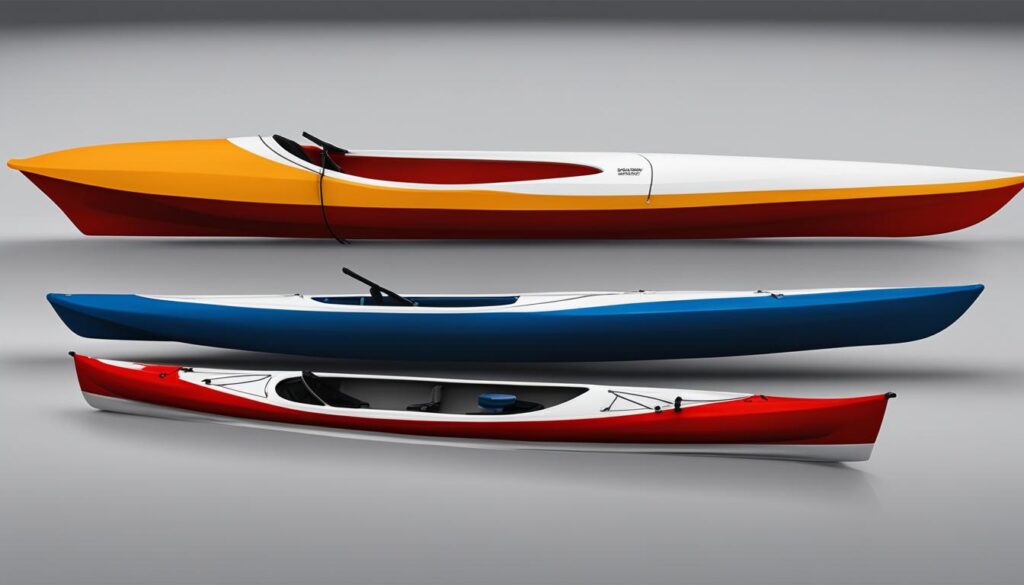
Kayak Deck Sizes and Cockpit Size Guide
When choosing a kayak, it’s important to consider the size and dimensions of both the deck and the cockpit. The deck size refers to the design of the kayak’s top surface, ranging from open-deck sit-on-top kayaks to partially and fully enclosed kayaks. The deck design plays a crucial role in providing shelter from waves, spray, and weather conditions. If you plan on kayaking in rough waters or challenging weather conditions, a fully enclosed kayak with a larger deck size may be more suitable. On the other hand, if you prefer the freedom of movement and easy access to the water, an open-deck sit-on-top kayak would be a better option.
The cockpit size is another important consideration. The cockpit refers to the opening in the kayak where you sit. It’s important to find a cockpit size that offers comfort and ease of entry and exit. Individuals with larger frames may require a bigger cockpit to accommodate their body size, while smaller individuals may prefer a more snug fit for added stability and control. Additionally, the width of the kayak also plays a role in stability and maneuverability. Wider kayaks offer more stability but may sacrifice speed, while narrower kayaks are more agile but require better balance and control.
To help guide your decision-making process, consider the following factors when selecting a kayak:
- The purpose of kayaking: Determine the type of kayaking activities you plan on engaging in, whether it’s leisurely paddling, fishing, touring, or tackling whitewater rapids. This will influence the ideal deck and cockpit size for your needs.
- Your body size and comfort: Take into account your height, weight, and body type when choosing a kayak. Larger individuals may require a bigger cockpit, while smaller individuals may prefer a more snug fit for better control.
- Paddling style and experience level: Consider your paddling style and experience level. If you’re a beginner, a kayak with a larger cockpit and wider width may offer more stability. Advanced paddlers may opt for narrower kayaks for increased maneuverability.
Table: Kayak Deck Sizes and Cockpit Size Recommendations
| Type of Kayak | Deck Size | Cockpit Size |
|---|---|---|
| Open-deck Sit-on-top Kayak | Large, open design | Variety of sizes available |
| Recreational Kayak | Partially enclosed | Medium to large cockpit |
| Sea/Touring Kayak | Fully enclosed | Medium to large cockpit |
| Whitewater Kayak | Partially or fully enclosed | Snug fit for better control |
Remember, selecting a kayak with the right deck size and cockpit size ensures comfort, ease of entry and exit, and the ability to enjoy your kayaking adventures to the fullest. Take your time to research and try different kayaks to find the perfect fit for your needs.
Transportation, Storage, and Tandem Kayaking
When choosing the right size kayak, it’s not just about the dimensions and fit for your body type – practical considerations like transportation and storage are equally important. You’ll want to ensure that you can easily transport your kayak to and from the water, as well as have a convenient storage solution when you’re not on the water.
Transportation
One factor to consider is the weight of the kayak. Depending on your physical capabilities and the ease of loading and unloading, you may want to choose a kayak that is lighter in weight. This will make it more manageable and reduce the risk of strains or injuries when moving it around. Additionally, it’s crucial to check the kayak’s weight limit to ensure that it can safely support your weight and any additional gear you might be carrying.
When transporting your kayak, you may need a roof rack or kayak trailer to secure it safely on top of your vehicle. It’s essential to follow the manufacturer’s guidelines for proper strapping and securing to prevent any accidents or damage to your kayak during transportation.
Storage
Considering your available storage space is also essential when choosing the right size kayak. If you have limited space at home, you may need to opt for a smaller kayak that can be easily stored in your garage, shed, or apartment. On the other hand, if you have plenty of storage space, you may have more flexibility in choosing a larger kayak.
Remember to account for the length of the kayak when measuring your storage area, as well as any additional space needed for accessories such as paddles and life vests. Proper storage will help prolong the lifespan of your kayak and protect it from any potential damage caused by exposure to the elements.
Tandem Kayaking
If you enjoy kayaking with a partner or friend, tandem kayaking is a great option. Tandem kayaks are specifically designed to accommodate two individuals comfortably. These kayaks are generally larger in size and have a higher weight limit to accommodate the combined weight of two paddlers.
When choosing a tandem kayak, it’s important to ensure that both paddlers have enough legroom and space to paddle comfortably without bumping into each other. Additionally, consider the weight capacity of the tandem kayak to ensure it can safely support both individuals and any gear you may bring along for your kayaking adventures.
By taking into account the practical aspects of transportation and storage, as well as considering the needs of tandem kayaking if applicable, you can choose the right size kayak that caters to your specific needs and enhances your overall kayaking experience.
| Kayak Considerations | Transportation | Storage | Tandem Kayaking |
|---|---|---|---|
| Weight | Consider the kayak’s weight for ease of transportation | Choose a kayak size that fits comfortably within your storage space | Opt for a larger kayak designed for tandem kayaking |
| Weight Limit | Check the kayak’s weight limit to ensure it can safely support your weight and gear | Account for additional space needed for accessories when measuring storage area | Select a tandem kayak with a higher weight limit to accommodate two paddlers |
| Roof Rack or Trailer | Use a roof rack or kayak trailer to secure the kayak safely during transportation | Properly store the kayak to protect it from damage caused by exposure to the elements | Ensure both paddlers have enough legroom and space to paddle comfortably |
Conclusion
Choosing the right size kayak is crucial for an optimal paddling experience. By considering factors such as the purpose of kayaking, length to width ratio, legroom, and kayak volume, you can select the ideal size that suits your specific needs and body type. Remember to also take into account practical considerations like transportation, storage, and whether you’ll be tandem kayaking.
By finding the perfect balance between comfort and maneuverability, you’ll be able to navigate the waters with confidence. Whether you’re a leisurely paddler, an avid angler, or an adventurous tourer, selecting the right size kayak will ensure that you’re well-equipped for your chosen activity.
So, measure your needs, evaluate the dimensions, and make an informed decision when it comes to the size of your kayak. With the right fit, you’ll be able to fully enjoy the beauty of kayaking and create unforgettable memories on the water.
FAQ
What factors should I consider when choosing the optimal kayak size?
Factors to consider include the purpose of kayaking, the length to width ratio, and the legroom needed for comfort and control.
What are the different types of kayaks and their dimensions?
Different types of kayaks, such as recreational, fishing, and sea/touring kayaks, have varying dimensions that cater to specific needs.
Does the length of a kayak significantly impact its performance?
No, a kayak’s length doesn’t significantly impact its performance, but the cockpit dimensions play a crucial role in providing a comfortable fit for different body types.
What does kayak volume refer to?
Kayak volume refers to the amount of space inside the kayak and is described using terms like low volume, medium volume, and high volume.
How do kayak deck sizes and cockpit sizes affect the paddling experience?
The deck design affects shelter from waves, spray, and weather conditions, while the cockpit size is important for comfort and ease of entry and exit.
What are some practical considerations when choosing a kayak size?
Practical considerations include transportation, storage, and if you plan on tandem kayaking, a larger kayak will be needed.
How do I choose the right size kayak for my needs?
By considering factors such as the purpose of kayaking, length to width ratio, legroom, and kayak volume, you can determine the ideal size that caters to your specific needs and body type.
Why is choosing the right size kayak important?
Choosing the right size kayak is essential for a comfortable and enjoyable paddling experience, ensuring optimal performance and fit.

